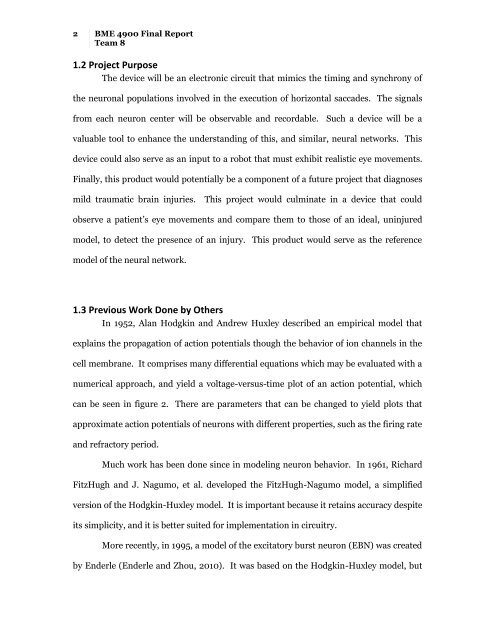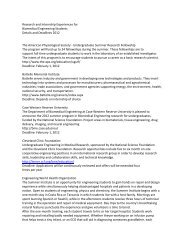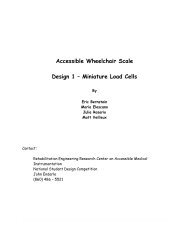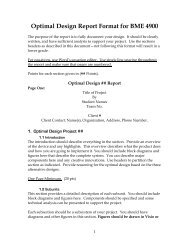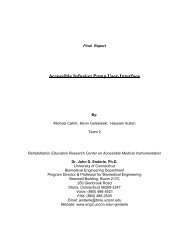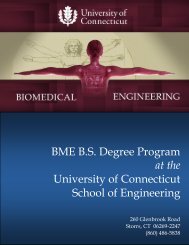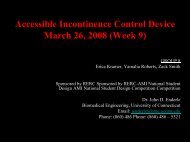BME 4900 Final Report - Biomedical Engineering - University of ...
BME 4900 Final Report - Biomedical Engineering - University of ...
BME 4900 Final Report - Biomedical Engineering - University of ...
Create successful ePaper yourself
Turn your PDF publications into a flip-book with our unique Google optimized e-Paper software.
2 <strong>BME</strong> <strong>4900</strong> <strong>Final</strong> <strong>Report</strong>Team 81.2 Project PurposeThe device will be an electronic circuit that mimics the timing and synchrony <strong>of</strong>the neuronal populations involved in the execution <strong>of</strong> horizontal saccades. The signalsfrom each neuron center will be observable and recordable. Such a device will be avaluable tool to enhance the understanding <strong>of</strong> this, and similar, neural networks. Thisdevice could also serve as an input to a robot that must exhibit realistic eye movements.<strong>Final</strong>ly, this product would potentially be a component <strong>of</strong> a future project that diagnosesmild traumatic brain injuries.This project would culminate in a device that couldobserve a patient’s eye movements and compare them to those <strong>of</strong> an ideal, uninjuredmodel, to detect the presence <strong>of</strong> an injury. This product would serve as the referencemodel <strong>of</strong> the neural network.1.3 Previous Work Done by OthersIn 1952, Alan Hodgkin and Andrew Huxley described an empirical model thatexplains the propagation <strong>of</strong> action potentials though the behavior <strong>of</strong> ion channels in thecell membrane. It comprises many differential equations which may be evaluated with anumerical approach, and yield a voltage-versus-time plot <strong>of</strong> an action potential, whichcan be seen in figure 2. There are parameters that can be changed to yield plots thatapproximate action potentials <strong>of</strong> neurons with different properties, such as the firing rateand refractory period.Much work has been done since in modeling neuron behavior. In 1961, RichardFitzHugh and J. Nagumo, et al. developed the FitzHugh-Nagumo model, a simplifiedversion <strong>of</strong> the Hodgkin-Huxley model. It is important because it retains accuracy despiteits simplicity, and it is better suited for implementation in circuitry.More recently, in 1995, a model <strong>of</strong> the excitatory burst neuron (EBN) was createdby Enderle (Enderle and Zhou, 2010). It was based on the Hodgkin-Huxley model, but


